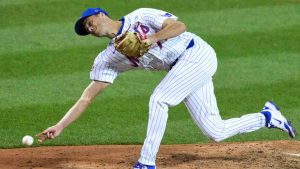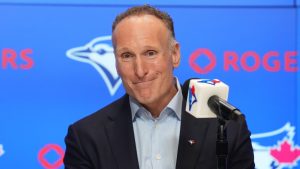When the Toronto Blue Jays 2024 season concludes on Sunday, it will go down as an unambiguous failure for the franchise.
The team entered the season with serious playoff aspirations, and even a season-ending sweep would leave them with a 77-85 record. These Blue Jays were a win-now team that will finish 2024 with a bottom-10 record.
While that gruesome bottom line is softened slightly by a few individual triumphs like Vladimir Guerrero Jr.’s excellent season or the emergence of Bowden Francis and Spencer Horwitz, there is no ducking the ugly big picture.
As tough a summer as it’s been, amidst the rubble of 2024 lies an opportunity to extract lessons that can serve the franchise in the future. That opportunity may not be as significant as the one squandered this year when the bar to reach the American League playoffs is so low — but it’s worth exploring nonetheless.
With that in mind, here are a few lessons the Blue Jays can draw from this turbulent season:
Bullpen volatility isn’t just a buzzword
Significant variance in year-to-year results for relievers is well-documented outside of a handful of elite high-leverage arms.
Even so, this fluctuation in results is relatively easy to shrug off under the assumption that some of your bullpen arms will outperform previous results while others will overperform, preventing massive swings in a full unit’s effectiveness.
The Blue Jays brought back almost the exact same bullpen in 2024 as they had in 2023, when the club’s reliever’s ranked eighth in the majors with a 3.68 ERA. Toronto featured seven of its top 10 relievers from 2023 (by innings pitched) in 2024 and almost all of them provided fewer and worse innings this year:
Some of those innings totals are skewed by mid-season trades, but those trades might not have happened if this group had performed well out of the gate.
The Blue Jays ran back a bullpen that worked last year with disastrous results. Not only do they have MLB’s worst bullpen fWAR (-2.5), the next worst team in the majors is well ahead (the Colorado Rockies at -0.1).
In terms of building a reliable relief group in the future that sidesteps this volatility, there are two primary options:
1. Invest a lot of money/trade highly ranked prospects to acquire elite relievers with a lengthy track record of year-to-year reliability.
2. Develop enough live arms internally that there are plenty of options when things inevitably go sideways for some of your relievers, like the Tampa Bay Rays were known for doing in their more successful seasons.
If the second path were viable for the Blue Jays, we wouldn’t have just seen so many innings from castoffs like Ryan Burr, Brendon Little, Tommy Nance, Dillon Tate, Yerry Rodriguez, Luis Frias, and Jose Cuas. That means it might be time to do some big spending at the back of the ‘pen – while also finding ways to develop more pitching.
Durability remains worth investing in
The Blue Jays have similar organizational depth issues in the rotation as they do in the bullpen, but those holes aren’t as glaring because their veterans rarely miss a start.
If Chris Bassitt pitches at least four innings in his final start that will mean four pitchers that began the year in Toronto’s rotation (Bassitt, Kevin Gausman, Jose Berrios, and Yusei Kikuchi) will finish 2024 with 175 innings pitched or more. That’s quite an achievement when just 27 MLB starters have hit that threshold heading into the final weekend.
None of the pitchers above were developed by the Blue Jays, and the club paid each a relatively hefty contract, all of which paid off nicely, even with Kikuchi’s bumpy 2022. This organization has put a premium on signing — or in the case of Berrios, retaining — durable starters, and they were rewarded in 2024 by not having to turn to Quad-A types or undercooked rookies at any point.
This isn’t revisionist history, either. The Blue Jays didn’t acquire starters who happened to stay healthy, they got players with a history of doing so.
Berrios hadn’t missed a start in three-and-a-half years before joining the team, Bassitt’s 402 innings in his three seasons before coming to Toronto ranked 19th in the majors, Gausman had made 30-plus starts in four of his prior five full seasons prior to his signing and Kikuchi’s 70 starts between 2019 and 2021 were 25th in MLB.
Of course, because the team had so many problems elsewhere it’s hard for them to take a victory lap on this one. It does provide solid evidence that their preference for workhorses is serving them well.
Both Gausman and Bassitt had seasons that don’t meet their recent standards, but they took their turn and prevented replacement-level guys from making starts. The whole rotation’s ERA of 3.87 ranks 11th in the majors despite a lack of individual greatness (outside of the late-season Francis run).
The rotation projects to be Toronto’s strength in 2025 and this group’s continued reliability is a huge reason why. If the team decides to add someone to the unit for next year, their preference for rubber arms will serve them well.
Swing decisions only take you so far
Much to the chagrin of Blue Jays fans, the team opened the season with a lineup full of hitters who knew how to get in favourable counts, take walks, and avoid strikeouts. Unfortunately for the club, they were simply unable to do much damage when given the opportunity.
It is not written in stone that the more disciplined you are the less power you’ll have. Guerrero, for instance, has a BB/K (0.75) way above league average (0.36) and he seems to put a charge into the ball just fine.
He’s a bit of an outlier — in a number of ways — and for most hitters there is a bit of a push and pull with power, contact, and discipline.
In the first half of the season the Blue Jays’ hitters were exhibiting solid process by working counts, but nothing was coming of it. When the team’s roster turned over at the trade deadline a younger cohort with a rawer approach was able to do more:
There is already an organizational movement towards a more power-first approach as that’s the strength of most of the team’s top hitting prospects, but there are more immediate adjustments to the lineup needed.
When the team goes shopping in free agency keeping power top of mind, particularly with Guerrero looking like the only returning position player who projects to bring significantly above-average power production to the 2025 Blue Jays.
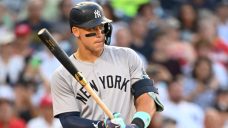

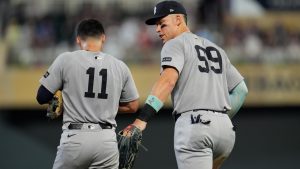
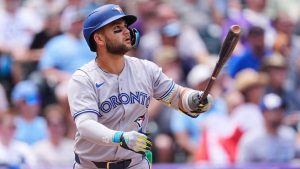 4:29
4:29